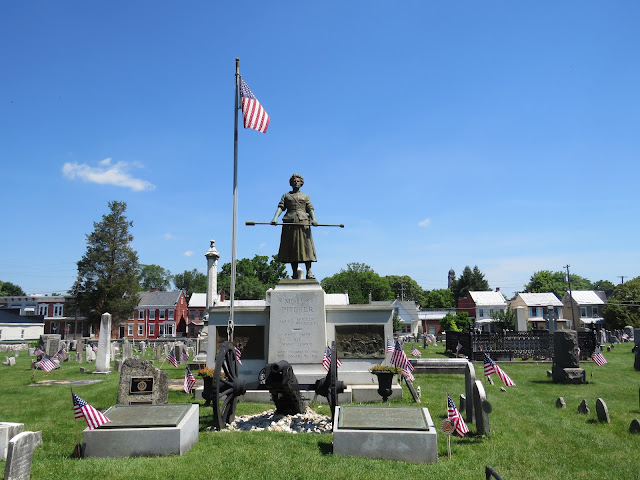After researching local history and genealogy for 50 years, I have traipsed through a fair number of cemeteries. (See "I See Dead Entrepreneurs" about Mount Auburn, and "I See Dead Entrepreneurs: Dr. Augustin Thompson and Moxie.")
As I was death cleaning some of my 1,404 image folders the other day, I decided I had enough odds and ends to assemble a Top 13 Favorite Gravestones list.
#13 The first chapter
of Innovation on Tap featured Eli Whitney, whose beautiful tombstone
sits in Yale’s Grove Street Cemetery.
Most people know
Whitney for this cotton gin and his firearms factory, but I covered his most
remarkable achievement in a 2013 post, “Not for the Squeamish: Eli Whitney’s Greatest Innovation.”
What makes the Grove Street Cemetery fascinating is the number of American innovators buried so closely to Whitney.
I have to hand it to John Gamble Kirkwood, too, who is one of the few people I have seen carve their entire resume into stone.
The War College occupies the vestiges of the Industrial School. Except for Jim Thorpe Drive, there’s not much Native American history to discover, though a website devoted to the school is excellent.
Only when I took a side street did I stumble upon the memorial to Molly Pitcher, or Mary Ludwig Hays, famous for fighting at the Battle of Monmouth during the American Revolution. When her husband was wounded, Molly took his place on the artillery piece, barely dodging death when “a cannon shot from the enemy passed directly between her legs without doing any other damage than carrying away all the lower part of her petticoat.”
#11 – The Princeton Cemetery is home to Aaron Burr, whose most infamous act is obscured in the granite of his other achievements and his rich family history. Buried nearby, his father was a president of Princeton, while his grandfather, Jonathan Edwards, was a revivalist preacher and another president of the college.
#10 – Buried near the Burr family is Grover Cleveland, the 22nd and 24th President of the United States, and his daughter, Ruth Cleveland—after whom the candy, Baby Ruth, was allegedly named.
#9 – The Wampanoag
Royal Burying Ground in Lakeville is a small, peaceful cemetery hosting about
twenty graves, many the descendants of Amie, the only child of Massasoit to
survive King Philip’s War. The last burial was in 1812, but memorials from
visitors are added monthly.
#6 – Lydia (Gulliver) Leonard (1656-1705) is my 8th great-grandmother (and daughter-in-law to one of New England’s first ironworkers, James Leonard. I wrote about the Leonards here.). Grandma Lydia would be surprised that her stone was being shown on something called the Internet in 2024. She rests with a bunch of my other relatives at the Neck ‘O Land Burying Ground in Taunton, where Old Colony will host a cemetery tour on July 13, 2024.
#5 – The Ayer Lion is an iconic memorial to James C. Ayer set in beautiful Lowell Cemetery, one of my favorite places to bird. James Ayer sold patent medicine and a lot of it. His magnificent lion gets boxed up every winter to be protected from the elements.
As one of the nation's earliest garden cemeteries, the Lowell Cemetery has several other striking memorials, which recall Lowell's enormous wealth in the 19th century.
#4 – On the road again (and not far) from the Lowell Cemetery is the
Edson Cemetery, the final resting place of Jean-Louis Lebris de Kérouac.
#3 – Not far from our home in Boxford, the Harmony Cemetery is the final resting place of General Solomon Lowe, whose four wives are arrayed in bas relief around his vault. I paid homage to General Lowe 12 years ago here. A native son of Boxford, he was representative to the General Court and a selectman.
Lowe’s will stipulated that beer be served near his vault on the anniversary of his death, a practice that soon got out of control and was disbanded by the sheriff. I wrote to the Boxford Historical Society years ago, suggesting that the practice be resumed as a fundraiser, but alas. I drive by the General on my way to Plum Island and usually wave.
#2 – The Green Mount Cemetery in Baltimore is home to the barely visible memorial of John Wilkes Booth, habitually buried by visitors in Lincoln head pennies.
#1 – My favorite memorial stone is that of William Hahn, located not far from Grover and Baby Ruth Cleveland in the Princeton Cemetery. Bill was not famous, but I bet knowing him would have been fun.





















































No comments:
Post a Comment